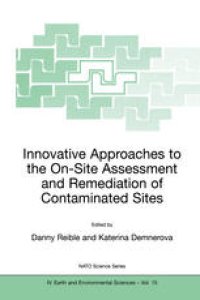
Ebook: Innovative Approaches to the On-Site Assessment and Remediation of Contaminated Sites
- Tags: Terrestrial Pollution, Atmospheric Protection/Air Quality Control/Air Pollution, Environmental Engineering/Biotechnology
- Series: NATO Science Series 15
- Year: 2002
- Publisher: Springer Netherlands
- Edition: 1
- Language: English
- pdf
2 DANNY D. REIBLEI AND KATERINA DEMNEROVA 1 Hazardous Substance Research Center/South and Southwest, Louisiana State University, Baton Rouge, LA 70803 2 Department of Biochemistry and Microbiology, Institute of Chemical Technology, Prague, Czech Republic On May 24, 2001, a total of 102 students and lecturers participated in an Advanced Study Institute (ASI) sponsored by the North Atlantic Treaty Organization (NATO) under our direction. The Institute was focused on in situ and onsite management of contaminated sites. The objective of the Institute was to balance state of the art science with techniques for field application of a variety of technologies for in situ assessment and remediation of contaminated sites. Many of the lecturers were drawn from the ranks of the Hazardous Substance Research Centers, multi-university consortia that have been funded by the US Environmental Protection Agency to conduct research and technology transfer designed to promote risk-based management and control of hazardous substances for the nation. The Centers have made special contributions to the areas of in situ and onsite assessment and remediation of contaminated sites. Such approaches have the potential for being significantly less expensive than other assessment and remediation approaches while maintaining accuracy and effectiveness. Cost-effective remedial and management approaches that are also effective in minimizing exposure and risk to human health and the environment are a critical need throughout the world but particularly in Eastern Europe and the former Soviet Union where resources that can be devoted to environmental cleanup are especially limited.
The in-situ and on-site assessment and remediation of contaminated sites, together with risk-based management and control of hazardous substances, are potentially less expensive than other assessment and remediation approaches, while maintaining accuracy and effectiveness. Cost-effective remedial and management approaches that are also effective in minimizing exposure and risk to human health and the environment are a critical need throughout the world, especially in Eastern Europe and the former Soviet Union, where resources that can be devoted to chemical cleanup are especially limited.
Although much of the focus of the book is on natural processes and how they might be enhanced for the management of contaminated sites, there is also a recognition that a portion of sites may require more invasive approaches, which are especially useful in managing source areas that contribute to the migration of contaminants in groundwater and other media. Among the more invasive approaches discussed are solvent extraction, direct bioremediation of PCBs, source areas and munitions, and chemical oxidation.